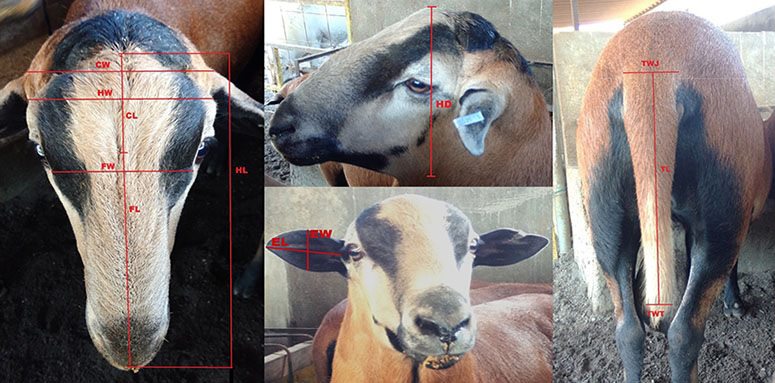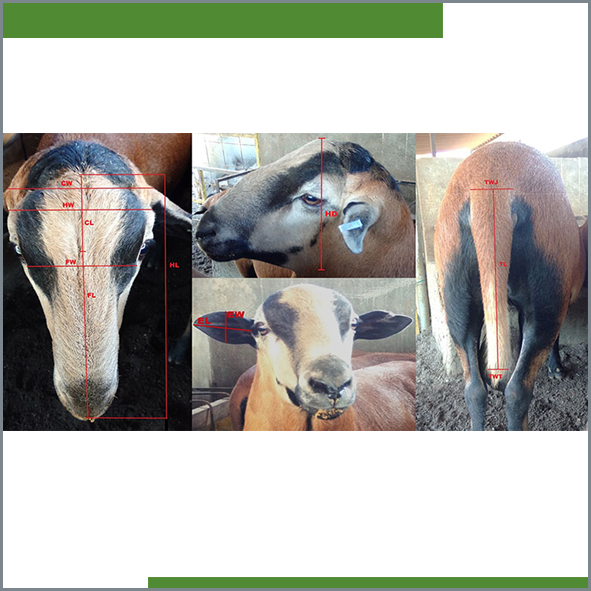Head and tail morphology of Pelibuey, Katahdin and Blackbelly rams in Colima, México
Main Article Content
Abstract
Veterinaria México OA
ISSN: 2448-6760
Cite this as:
- Macedo Barragán RJ, Arredondo Ruiz V, Cervantes Lechuga A. Head and tail morphology of Pelibuey, Katahdin and Blackbelly rams in Colima, México. Veterinaria México OA. 2016;3(3). doi: 10.21753/vmoa.3.3.375
A study was conducted with the objective of characterizing, comparing and analyzing the cephalic and caudal morphologies of Pelibuey, Katahdin and Blackbelly rams in the state of Colima, Mexico. A total of 53 rams, up to 2 years of age were scored for the following12 cephalic and caudal measurements: cranial width, cranial length, head width, head length, head depth, face width, face length, ear width, ear length, tail length, tail width at the joint and tail width at the tip. Katahdin rams had a significantly greater cranial width, head width and tail at the tip width than Pelibuey and Blackbelly rams (P ≤ 0.02). The tail width at the joint was greater in Katahdin rams than in Pelibuey rams (P = 0.01), and Blackbelly rams have intermediate values. Canonical analysis identified two significant canonical variables, CAN1 and CAN2, which accounted for 92% and 8% of the total variation, respectively. Katahdin rams were separated from Pelibuey and Blackbelly rams by the tail width the tip, while the head length and tail width at the joint differentiated the Pelibuey and Blackbelly rams. All Katahdin rams were correctly assigned within their breed group, while most Pelibuey rams (58.60%) were erroneously grouped as Blackbelly. Likewise, a significant proportion of the Blackbelly rams (40%) were misclassified as Pelibuey. Although Pelibuey, Blackbelly and Katahdin rams meet the standards of their respective breeds, phenotypic characterization using canonical discriminant analysis demonstrated the existence of a high degree of crossbreeding among these breeds and showed that the head length, tail width at the tip and tail width at the joint were the most discriminating variables for identifying and separating the three sheep breeds.

Article Details
References
[AMCO] Asociación Mexicana de Criadores de Ovinos. 1998. Lineamientos para la Clasificación de las Razas Ovinas en México. DF, México: AMCO.
Arora R, Bhatia S, Jain A. 2010. Morphological and genetic characterization of Ganjam sheep. Animal Genetic Resources, 46:1-9. DOI:10.1017/S2078633610000627.
Arredondo RV, Macedo BR, Molina CJ, Magaña AJ, Prado RO, García MLJ, Herrera CA, Lee RH. 2013. Morphological characterization of Pelibuey sheep in Colima, México. Tropical Animal Health and Production, 45:895-900. DOI: 10.1007/s11250-012-0303-1.
Arredondo RV, Macedo BRJ, Cruz EC, Prado RO, García MLJ. 2016. Caracterización de las unidades de producción ovinas de los productores organizados de Colima, México. Actas Iberoamericanas de Conservación Animal, 7:31-36.
Asamoah-Boaheng M, Sam EK. 2016. Morphological characterization of breeds of sheep: a discriminant analysis approach. SpringerPlus, 5. DOI: 10.1186/s40064-016-1669-8.
Atto MJA. 2007. Importancia de los ovinos tropicales introducidos al país: características productivas y reproductivas. Archivos Latinoamericanos de Producción Animal, 15(Supl. 1):310-315.
Bravo S, Sepúlveda N. 2010. Índices zoométricos en ovejas criollas Araucanas. International Journal of Morphology, 28:489-495.
Carrillo A, Segura JC. 1993. Environmental and genetic effects on preweaning growth performance of hair sheep in Mexico. Tropical Animal Health and Production, 25:173-178.
Cienfuegos REG, González RA, Hernández MJ, Zárate FP, Ibarra HMA, Lucero MFA, Martínez GJC. 2010. Mejoramiento genético de la producción ovina mediante estrategias de cruzamientos con razas de pelo. Archivos Latinoamericanos de Producción Animal, 18:49-56.
Cyrman AS. 1982. Técnica de fijación de pene en borregos receladores [tesis de licenciatura]. Veracruz, México: Universidad Veracruzana.
Dzib CA, Ortiz de Montellano A, Torres-Hernández G. 2011. Variabilidad morfoestructural de ovinos Blackbelly en Campeche, México. Archivos de Zootecnia, 60:1291-1301.
[FAO] Food and Agriculture Organization. 2012. Phenotypic Characterization of Animal Genetic Resources. Rome, Italy: FAO Animal Production and Health Guidelines.
Gizaw S, Komen H, Hanotte O, van Arendonk JAM, Kemp S, Haile A, Mwai O, Dessie T. 2011. Characterization and conservation of indigenous sheep genetic resources: A practical framework for developing countries. ILRI Research Report No. 27 Addis Ababa, Ethiopia: International Livestock Research Institute.
Gomes AJK, Vieira da Silva NM, de Barros NR, Pimenta FEC, de Albuquerque BLH, Ribeiro MN. 2016. Multivariate analysis as a tool for phenotypic characterization of an endangered breed. Journal of Applied Animal Research, 44. DOI: 10.1080/09712119.2015.1125353.
González A, Murphy BD, Foote WC, Ortega E. 1992. Circannual estrous variations and ovulation rate in Pelibuey ewes. Small Ruminant Research, 8:225-232.
Gwala PE, Kunene NW, Bezuidenhout CC, Mavule BS. 2015. Genetic and phenotypic variation among four Nguni sheep breeds using random amplified polymorphic DNA (RAPD) and morphological features. Tropical Animal Health and Production, 47:1313-1319. DOI: 10.1007/s11250-015-0865-9.
Handiwirawan E, Noor RR, Sumantri C, Subandriyo. 2011. The differentiation of sheep breed based on the body measurements. Journal of the Indonesian Tropical Animal Agriculture, 36:1-8.
Herrera M, Luque M. 2009. Morfoestructura y sistemas para el futuro en la valoración morfológica. In: Sañudo AC (ed). Valoración Morfológica de los Animales Domésticos. Madrid, España: Ministerio de Medio Ambiente y Medio Rural y Marino.
[INEGI] Instituto Nacional de Estadística Geografía e Informática. 2010. Anuario Estadístico de Colima 2010. Aguascalientes, México: INEGI.
López-Carlos MA, Ramírez RG, Aguilera-Soto JI, Aréchiga CF, Rodríguez H. 2010. Size and shape analyses in hair sheep ram lambs and its relationships with growth performance. Livestock Science, 131:203-211. DOI: 10.1016/j.livsci.2010.04.001.
Macías-Cruz U, Álvarez-Valenzuela FD, Olguín-Arredondo HA, Molina-Ramírez L, Avendaño-Reyes L. 2012. Ovejas Pelibuey sincronizadas con progestágenos y apareadas con machos de razas Dorper y Katahdin bajo condiciones estabuladas: producción de la oveja y crecimiento de los corderos durante el período predestete. Archivos de Medicina Veterinaria, 44:29-37. DOI: 10.4067/S0301-732X2012000100005.
Pares CPM. 2009. Zoometría. In: Sañudo AC (ed). Valoración Morfológica de los Animales Domésticos. Madrid, España: Ministerio de Medio Ambiente y Medio Rural y Marino.
Romualdo JG, Sierra AC, Ortiz JR, Hernández JS. 2004. Caracterización morfométrica del ovino Pelibuey local en Yucatán, México. Archivos Latinoamericanos de Producción Animal, 12(Supl. 1):26-31.
Ruz JG. 1966. Estudio del Ovino Tropical «Peligüey» del Sureste de México y sus Cruzas con Ovino Merino [tesis de licenciatura]. DF, México,: Universidad Nacional Autónoma de México.
Salako AE. 2013. Genetic and phenotypic profiles of West African dwarf and Yankasa sheep breeds in Nigeria. International Journal of Biodiversity and Conservation, 5:47-53. DOI: 10.5897/IJBC11.012.
Sarma K. 2006. Morphological and craniometrical studies on the skull of Kagani goat (Capra hircus) of Jammu region. International Journal of Morphology, 24:449-455.
[SASI] SAS Institute. 2002. The SAS System, release 9.0 for Windows. Cary, North Carolina, USA [access: 25 sep 2013].
Vilaboa AJ, Bozzi R, Díaz RP, Bazzi L. 2010. Conformación corporal de las razas ovinas Pelibuey, Dorper y Kathadin en el estado de Veracruz, México. Zootecnia Tropical, 28:321-328.
Wildeus S. 1997. Hair sheep genetic resources and their contribution to diversified small ruminant production in the United States. Journal of Animal Science, 75(3):630-640.
Yakubu A, Ibrahim IA. 2011. Multivariate analysis of morphostructural characteristics in Nigerian indigenous sheep. Italian Journal of Animal Science, 10:83-86. DOI: 10.4081/ijas.2011.e17.
License

Veterinaria México OA by Facultad de Medicina Veterinaria y Zootecnia - Universidad Nacional Autónoma de México is licensed under a Creative Commons Attribution 4.0 International Licence.
Based on a work at http://www.revistas.unam.mx
- All articles in Veterinaria México OA re published under the Creative Commons Attribution 4.0 Unported (CC-BY 4.0). With this license, authors retain copyright but allow any user to share, copy, distribute, transmit, adapt and make commercial use of the work, without needing to provide additional permission as long as appropriate attribution is made to the original author or source.
- By using this license, all Veterinaria México OAarticles meet or exceed all funder and institutional requirements for being considered Open Access.
- Authors cannot use copyrighted material within their article unless that material has also been made available under a similarly liberal license.



